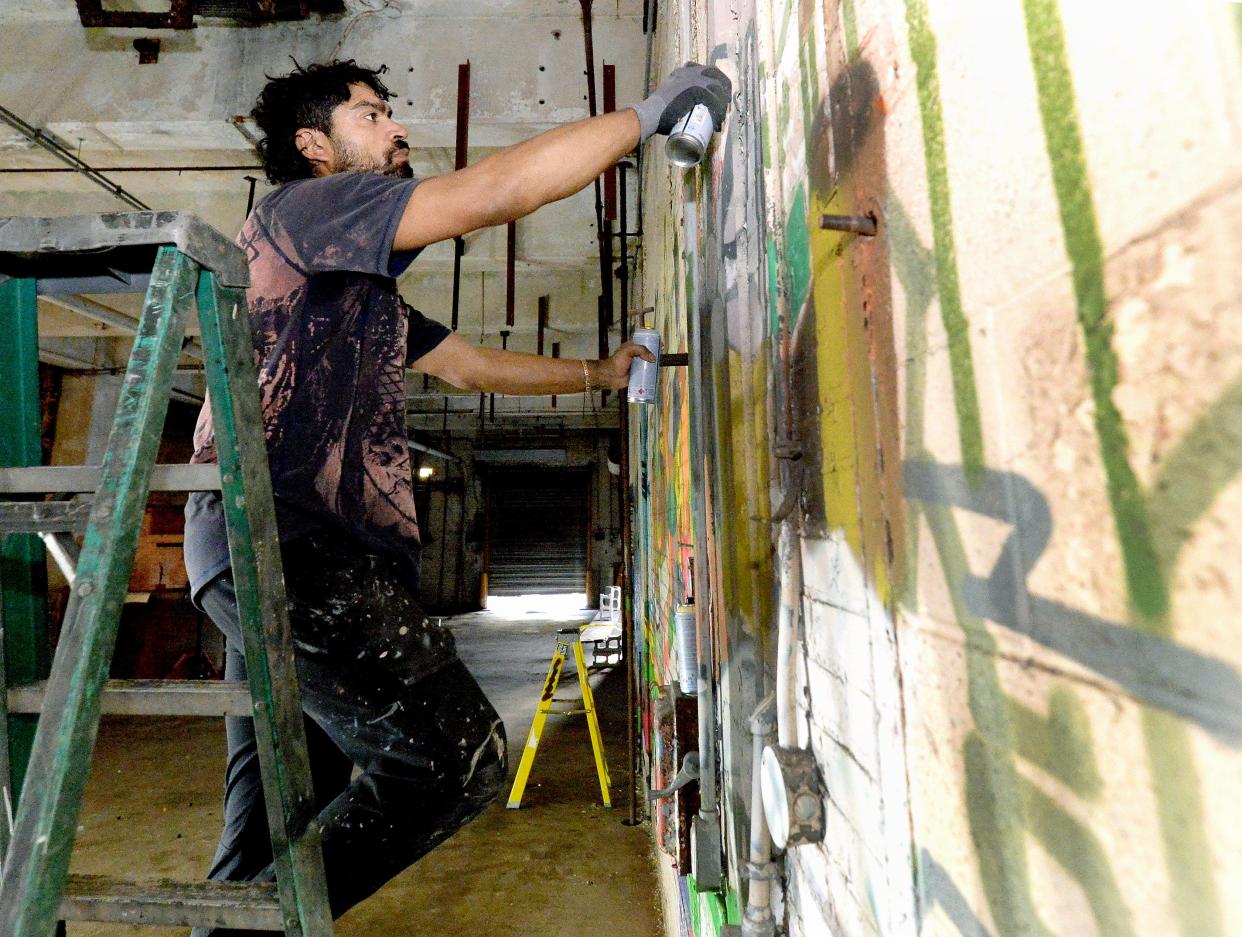Art exhibitions, recovered items provide backdrop for Pillsbury tours

Robert Mazrim, curator of Moving Pillsbury Forward, freely admits that when someone is milling around a vacant property in the middle of the night, it's not normally good.
But Mazrim and Moving Pillsbury Forward's president Chris Richmond were actually seeking out whoever was putting together well-designed graffiti artwork within the walls of the old Pillsbury mill at the corner of 15th and Phillips streets.
Those two artists – a pair of Minneapolis-based graffiti artists named Shock and Static – along with other graffiti artists and local sculptors, will have their art showcased as part of a 15,000 square-foot art exhibit called "Visitors" that opens to the public Thursday 5:30-8 p.m. inside the "C-Mill" building on the far north end of the site.
More: Senators Durbin, Duckworth introduce bill to expand boundaries of the Lincoln Home site
Admission is free, but access to the full site will be limited. Anyone attending is asked to dress accordingly due to a lack of heat and to wear sturdy shoes on the old factory floors.
Move Pillsbury Forward is responsible for cleaning up the former Pillsbury Mills site and setting the stage for the redevelopment of the 18 acres. This includes remediation and demolition of the existing structures. Regulatory approval is necessary before the plan can move ahead but in the meantime, the group is hosting a series of community events to educate the public about the former grain and flour plant.
The exhibit follows in the footsteps of another exhibit at the site, Echoes of Pillsbury, which is dedicated to preserving the history of the former flour mill, which opened in 1930 at a cost of $1 million and closed in 2001 after being sold. The exhibit showcases items recovered by Moving Pillsbury Forward on the site, such as production materials and items used by workers in making flour.
People on tours of the site have the opportunity to go through and see the exhibit, which provides plenty of history despite being in a small space. Richmond said that about 500 people had seen the exhibit.
"A lot of people ask me if we'll try to make that a more permanent exhibit somewhere in town," Richmond said. "That remains to be seen. Right now, we don't have a city museum or a museum of manufacturing and industry here in Springfield. No doubt, we are going to offer many of the items in that exhibit to museums, whether that be the Illinois State Museum or other museums that may have interest."
For the art exhibit, Richmond said that they had artist visitors – which, as it turned out, included Shock and Static – come to the site to do graffiti work. Richmond appreciated the talent of these people, but it was the accidental meeting between Richmond, Mazrim, and Shock in September that ended up leading to the graffiti exhibit.
As Shock tells it, he and his partner were driving back to Minnesota from St. Louis when their car broke down in a nearby grocery store parking lot in Springfield. Since they had already visited the site, they wanted to return and do some more art under the cover of darkness.
Richmond and Mazrim were driving a pick-up truck and checking for anyone who might be trespassing on site when they found Shock and Static's bags, put them in the back of the truck, then looked for the two men. Mazrim then struck up a conversation with Shock and realized that he wasn't a thief looking for copper, he was an artist.

"I'm trying to figure out who these people are and where they're coming from," Mazrim said. "We get people breaking in all the time looking for copper and you can tell the public that there's no copper left to steal, but they give it a try. Nine times out of 10, when we take that pick-up truck and see someone crawling out of a window, they've got bolt-cutters and a spool of copper wire.
We noticed a few days before that there was new art popping up and some of it was still fresh that you could smell the paint from it. I had this sense that these guys might still be here. I got another call from Chris that said, 'We've got somebody breaking in, but they're not taking copper, they're taking art supplies.'"
That conversation led to roles as artist-in-residence for Shock and Static, living in Springfield, and working on the project, which explores themes and feelings of the rise and fall of the mill and the surrounding community. Because the site is going to be demolished at some point in the next 18 months, whatever Shock and Static create is likely to be destroyed once the site is cleared.
Shock said that he'll shed a tear when the C-Mill is torn down, but understands that a lot of what he does gets removed anyway.
More: Springfield City Council adopts moratorium on residency requirement for municipal workers
"We're used to our work being gone immediately," Shock said. "If something that I did in the city rode for 18 months, I'd be glad. Graffiti is a very temporary art form, so we're just used to that. That's why it's perfect."
In a sense, he said that the exhibit gives the doomed Pillsbury site a distinguished funeral before it's demolished and redeveloped.
"It sort of dawned on us that that's what this is about," Shock said. "This is kind of the funeral, the eulogy of this place and what this place represents. It's a big thing, an important part of this country and ourselves and who we are. I think it needs a proper burial if we're going to move forward."
This article originally appeared on State Journal-Register: New exhibitions at Pillsbury plant provide color to old grounds
